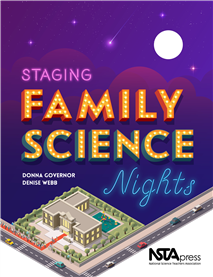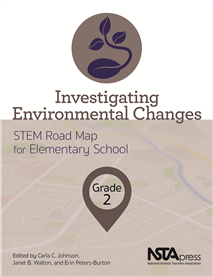All Book Chapters
Book Chapter
In this chapter, we look at postproduction tasks, such as surveying the audience, reflecting on your event, following up with stakeholders and taking your event on the road. In closing this chapter, the authors provide a summary of why they have beco...
Book Chapter
The guiding question for this activity is, “How can you balance a bug on your finger?” Symmetrical balance is when all the elements on both sides of the center are equal. Students will be making symmetrical bugs to balance and can design their ow...
Book Chapter
The guiding questions for this activity are, “What soap makes the best bubbles and can you make bubbles in different shapes?” As bubbles pop and students experiment, think also about which solution gave the biggest bubble and what makes them pop....
Book Chapter
The guiding question for this activity is,“How can you design a catapult that will launch a marshmallow?” Students are given materials needed to make a catapult and they will try over and over again to launch a marshmallow. An explanation of the ...
Book Chapter
The guiding question for this activity is,”How do waves carry energy? Students use recycled water bottles filled with colored water and a type of oil to demonstrate a wave. They will also learn about energy, mechanical waves, and medium. An expla...
Book Chapter
The guiding questions for this activity are, “What happens when different colors are combined and can some substances be both a solid and a liquid?” Students will learn about primary colors, secondary colors, and non-newtonian mixture. Slime acts...
Book Chapter
The guiding question for this activity is, “How can you design a boat to hold the most weight possible?” In this activity, students make foil boats and the most important concept to emphasize is the engineering cycle. Students will learn about f...
Book Chapter
The guiding question for this activity is,“How does camouflage help animals survive?” During the event, suggest students try different combinations of colors and shapes for camouflage. Students will learn about camouflage, as well as adaptations,...
Book Chapter
The guiding questions for this activity are,“What are the needs of a plant and what are the parts of the plant?” Growing plants have different parts with roots underground and the stem is the upper part that holds leaves and flowers. In this acti...
Book Chapter
The guiding question in this activity is,“How is sound produced?” In this activity, students assemble harmonicas to learn about vibration, pitch, and harmony. The science behind the activity explains how sound is created when something vibrates....
Book Chapter
The guiding questions for this activity are,“How does ice cream freeze and why does it melt?” In this activity, students make ice cream which is a fun but messy event. While making the ice cream, they can observe a phase change of a liquid freezi...
Book Chapter
The guiding questions for this activity are,“How is sound produced and can you make an instrument that produces sound?” Make sample maracas for the students to try and then provide real maracas of different shapes and sizes for students to play w...
Book Chapter
The guiding question for this activity is,”What causes the pinwheel to spin?” In this activity, students decorate and put together pinwheels and will learn that pinwheels are designed to capture moving air and when the wind blows into the pinwhee...
Book Chapter
The guiding question for this activity is,“How can air be used to move something?” Large air cannons can be made or purchased for students to experiment with while waiting to create ones of their own. An explanation of the science behind the acti...
Book Chapter
The guiding question for this activity is,“How does energy cook food?” Students use heat lamps to cook their s’mores. The science behind the activity provides more detail on heat and how energy is transferred from one object to another because ...
Book Chapter
The guiding questions for this activity are,“How do vibrations cause sound and how can you change the pitch of the sound?" Sound is a wave produced by vibrating air. Students will make a bug buzzer and discover that changing the speed at which you ...
Book Chapter
The guiding question in this activity is,“How do fossils form?” Fossils are remains and traces of plants and animals that lived long ago. In this activity, a sandbox is set up for students to dig for dinosaur “fossils” to create a cast “fos...
Book Chapter
The guiding questions in this activity are,“How do magnets interact with other objects and how can magnetism make iron filings move?” In this activity, students use iron fillings to explore magnetism as a pulling force. In addition to force, stud...
Book Chapter
The guiding questions in this activity are,“How can density be used to separate fluids and what happens when fluids of different densities are mixed together?” In this activity, students make lava lamps using baby bottles as test tubes and add a ...
Book Chapter
The guiding questions in this activity are,“How does a parachute work and what design will make the parachute slow down the most?” The goal of this activity is to encourage creative thinking and engage students in the engineering cycle. Give stud...
Book Chapter
The guiding questions in this activity are,“What are the parts of a flower and what are the parts of a seed?” In this activity, students dissect cut flowers and lima beans that have been soaked in water. Students will also learn about pollen and ...
Book Chapter
The guiding question in this activity is,“How can you design a roller coaster track that keeps the marble moving from beginning to end, without it falling off?” In this activity, students design a roller coaster using insulation tubing. They will...
Book Chapter
The guiding questions in this activity are,“What is static electricity and what causes static electricity?” A number of activities are used to explore static electricity so a large room with multiple tables is needed. Students will also learn abo...
Book Chapter
The guiding question for this activity is,“How can you design a straw rocket to go the farthest distance?” Encourage students to use the engineering cycle to design, test, and then improve their rocket. A detailed science behind the activity is ...
Book Chapter
The guiding questions for this activity are,”How does surface tension affect movement in liquids and how many drops of water can a penny hold before the water slides off?” In this activity, students experiment with water striders and placing wate...
Book Chapter
The guiding question for this activity is,“What design will help your car move the fastest and farthest?” In this activity, students will build balloon-powered cars. A number of materials can be used for this engineering challenge but the ones s...
Book Chapter
The guiding question for this activity is,“How does a Cartesian diver work?” In this activity, students make Cartesian divers and are challenged to make the bubble the right size in the pipette for the diver to work. A detailed science behind the...
Book Chapter
The guiding questions for this activity are,“What is a chemical reaction and how can you tell when a chemical reaction occurs?” In this activity, students fill balloons with a mixture of water, baking soda, and vinegar to see what happens. A deta...
Book Chapter
The guiding questions for this activity are,“How is potential energy stored and how is potential energy converted to kinetic energy?” Different size cup lids are used in this activity to help students with the cylinder for making hall rollers. St...
Book Chapter
The guiding question for this activity is,“How does a hovercraft work? In this activity, students use film canisters to make a hovercraft. A detailed science behind the activity is provided and highlights friction. Before beginning this activity, w...
Book Chapter
The guiding question for this activity is,“How is light reflected?” In this activity, students make kaleidoscopes to experiment with light. A science beyond the activity is provided and highlights the reflection of light. Before beginning this ac...
Book Chapter
The guiding question in this activity is,“How do our lungs help us breathe?” In this activity, students use recycled water bottles with a cut balloon stretched over the top to demonstrate how the diaphragm functions. A science beyond the activity...
Book Chapter
The guiding questions in this activity are,“Are all rocks formed the same way and how does rock change during the rock cycle?” Rocks are constantly being recycled on Earth and what happens to a rock depends on the conditions it is exposed to. Stu...
Book Chapter
The guiding question in this activity is,“How does energy flow through an ecosystem?” You will need to purchase sterilized owl pellets from a reputable vendor for this activity. While we recommend events be free, this activity is very popular and...
Book Chapter
The guiding question for this activity is,“How can you design a paper airplane to go the farthest distance?” In this activity, students make paper airplanes to demonstrate the forces of flight. Students will also learn about force, thrust, drag,...
Book Chapter
The guiding question in this activity is,“Do all liquids have the same density?” Students use plastic specimen collection tubes that are purchased in bulk to determine the density of liquids used. A detailed science behind the activity is provide...
Book Chapter
The guiding question in this activity is,“How does a circuit work?” Old Christmas light strands work great for this activity to help students understand circuits. A detailed science behind the activity is provided. Students will also learn about ...
Book Chapter
Investigating Environmental Changes, Grade 2: STEM Road Map for Elementary School (Book Sample)
What if you could challenge your second graders to design an outdoor STEM classroom with a butterfly garden, birdbath, and sundial? With this volume in the STEM Road Map Curriculum Series, you can! Investigating Environmental Changes outlines a j...
Book Chapter
Let’s Explore Environmental Changes Over Time!
In this lesson, students consider the various types of environmental changes that occur over time and participate in a class investigation of the causes and effects of erosion. They also begin to consider ways in which environmental changes can be tr...
Book Chapter
Planning Our Outdoor STEM Classroom
This lesson introduces students to the engineering design process (EDP) as a way to plan and construct an outdoor STEM classroom. Students will use the EDP by working through its steps together to design a birdbath.They learn about dialogue in fictio...




